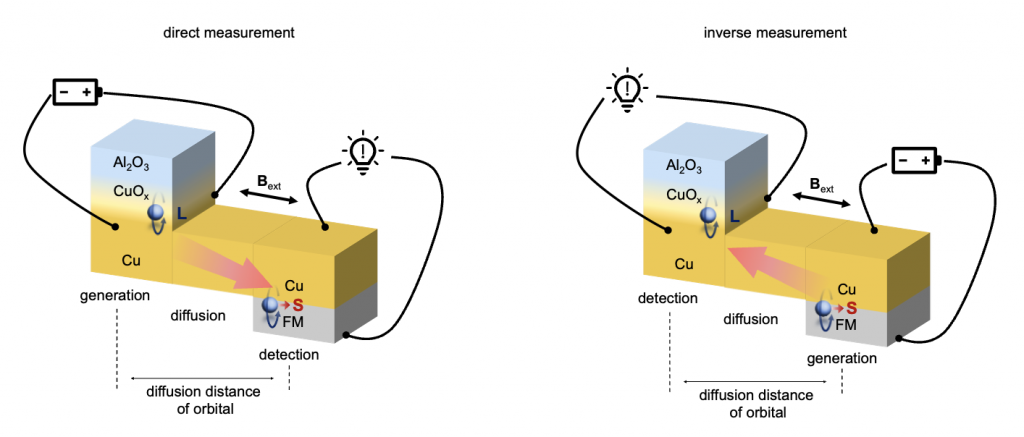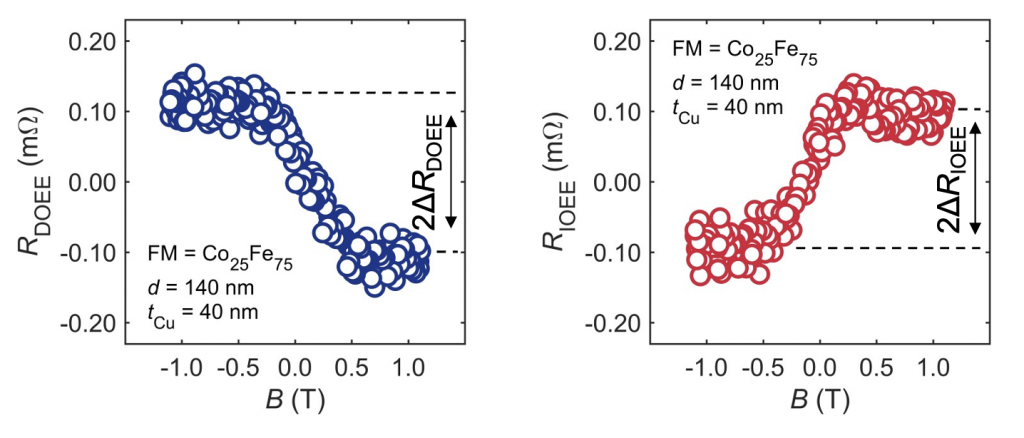Onsager’s reciprocal relationship of orbital Edelstein effect in Al2O3/CuOx/Cu/FM system: verified by nonlocal electrical measurement
A research team led by graduate student Weiguang Gao, Project Researcher Liyang Liao, then-Assistant Professor Hironari Isshiki, and Professor YoshiChika Otani at the Institute for Solid State Physics (ISSP), the University of Tokyo, in collaboration with Associate Professor Shinji Miwa (ISSP), Dr. Junyeon Kim (National Institute of Advanced Industrial Science and Technology), Professor Yuriy Mokrousov and Dr. Dongwook Go (Peter Grünberg Institute, Forschungszentrum Jülich, Germany), Professor Hyun-Woo Lee (POSTECH, South Korea), and Professor Kyung-Jin Lee (KAIST, South Korea), has successfully measured and analyzed both the orbital Edelstein effect—which induces orbital magnetization (orbital accumulation) from an electric current—and its reciprocal, the inverse orbital Edelstein effect, which generates an electric current from orbital accumulation, using a single device.
This achievement marks the first experimental verification of the Onsager reciprocal relationship between these two effects.
Electrons possess two intrinsic degrees of freedom: spin and orbital. While spin degrees of freedom have long been harnessed in spintronics to add new functionalities to electronics—such as via the spin Hall effect and spin torque—the orbital counterpart has only recently emerged as a promising frontier. Orbitronics, which exploits orbital degrees of freedom, holds great promise for next-generation energy-efficient and high-speed electronics, as it enables spin-like effects to arise even in light elements and with minimal energy loss. A crucial requirement for orbitronics is the ability to interconvert charge current and orbital angular momentum, but such interconversion had not been experimentally demonstrated until now.
In this study, the researchers experimentally confirmed orbital accumulation induced by passing current through a CuOx/Cu interface, as well as the inverse process—electric current generation from accumulated orbital angular momentum. They further revealed that the orbital decay length (approximately 100 nm at room temperature) is independent of Cu film thickness and decreases as temperature is lowered. These findings establish a fundamental basis for the development of novel electronic devices that leverage orbital angular momentum and are expected to open new design paradigms in the field of orbitronics.
This achievement was published in Nature Communications on July 10, 2025.
Research Background
Electrons carry two distinct angular momenta: the spin angular momentum S and orbital angular momentum L which can be used for information processing. Recently, researchers found that L surpass S because it less relies on heavy metal (wider and more environmentally friendly materials selection) and have higher torque efficiency (promise a higher information processing speed). A key mechanism in this field is the orbital Edelstein effect (OEE), which means if an electric current is applied to the orbital Edelstein system (such as CuOx/Cu interface), the nonequilibrium L can be induced. However, experimental verification of its Onsager reciprocity, which suggests that charge current can convert to orbital current and vice versa, has been lacking.
This study experimentally demonstrates Onsager’s reciprocity of orbital transport in an orbital Edelstein system by utilizing nonlocal electrical measurements (Fig.1). This method spatially separates the orbital generation and signal detection sites and enables the precise identification of the nonlocal generated by orbital accumulation. Additionally, this study finds that the orbital decay length, approximately 100 nm at room temperature, is independent of the Cu thickness and decreases with decreasing temperature, revealing a distinct contrast to the spin transport behavior. This work provides valuable insights into both the reciprocity of the charge-orbital interconversion and the nonlocal correlation of orbital degree of freedom, laying the ground for orbitronics devices with long-range interconnections.

Research Content
In direct measurement (left panel in Fig.1), an electric current is applied to the CuOx/Cu nanowire where the nonequilibrium L is induced. The nonequilibrium L then diffuses to ferromagnetic (FM) nanowire and generates a voltage signal. Conversely, in inverse measurement (right panel in Fig.1), an electric current is applied to the FM nanowire where the nonequilibrium L is induced. The nonequilibrium L then diffuses to CuOx/Cu nanowire and generates a voltage signal.
The research team find that in the sample with diffusion distance of orbital larger than 100 nm, the clear nonlocal orbital response occurs (Fig.2 left and right panel). Moreover, the overall change of the responses follows the relation: 2ΔRDOEE = −2ΔRIOEE. Those results suggest that orbital Edelstein effect obeys the Onsager’s reciprocal relation.

To further understand the orbital transport, researchers further perform the Cu thickness dependence and temperature dependence, which reveals that the orbital decay length, approximately 100 nm at room temperature, is independent of the Cu thickness and decreases with decreasing temperature, revealing a distinct contrast to the spin transport behavior.
Outlook
This work experimentally verifies the Onsager reciprocal relation for orbital-charge interconversion, establishing a key symmetry in orbital transport. It also reveals several physical properties of orbital accumulation that are distinct from spin, such as their FM dependence, decay behavior and temperature dependence. These findings provide a foundation for further developments in orbital-based electronics and pave the way for inter-connectable orbitronics devices capable of operating over long distances.
Publication
- Journal:Nature Communications
- Title:Nonlocal electrical detection of reciprocal orbital Edelstein effect
- Authors:Weiguang Gao, Liyang Liao, Hironari Isshiki, Nico Budai, Junyeon Kim, Hyun-Woo Lee, Kyung-Jin Lee, Dongwook Go, Yuriy Mokrousov, Shinji Miwa & Yoshichika Otani* (Corresponding author)
- DOI:10.1038/s41467-025-61602-7
